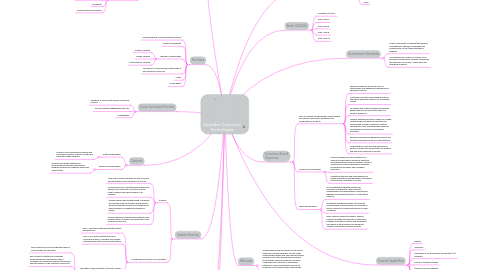
1. Subjects
1.1. Digital Technologies
1.1.1. Students use computational thinking and information systems to define, design and implement digital solutions.
1.2. Design and Technologies
1.2.1. Students use design thinking and technologies to generate and produce designed solutions for authentic needs and opportunities
2. Key Ideas
2.1. Overarching idea: Creating preferred futures
2.2. Project management
2.3. Thinking in Technologies
2.3.1. Systems Thinking
2.3.2. Design Thinking
2.3.3. Computational Thinking
2.4. Information & communication technology in the Australian Curriculum
2.5. Safety
2.6. Animal Ethics
3. Student Diversity
3.1. Purpose
3.1.1. Help ensure that all students are able to access and participate in the Australian Curriculum
3.1.2. Provide advice as to how the three-dimensional design of the Australian Curriculum may be used to address the learning needs of all students
3.1.3. Provide specific advice with regard to meeting the learning needs of students with disability, gifted and talented students, and students for whom English is an additional language or dialect
3.1.4. Provide examples illustrating how students with diverse needs can access and participate in the Australian Curriculum
3.2. An Australian Curriculum for all students
3.2.1. Goal 1: Australian schooling promotes equity and excellence
3.2.2. Goal 2: All young Australians become successful learners, confident and creative individuals and active and informed citizens
3.2.3. The Shape of the Australian Curriculum Version 4 (ACARA 2012)
3.2.3.1. Each student can learn and that the needs of every student are important
3.2.3.2. Each student is entitled to knowledge, understanding and skills that provide a foundation for successful and lifelong learning and participation in the Australian community
3.2.3.3. High expectations should be set for each student as teachers account for the current level of learning of individual students and the different rates at which students develop
3.2.3.4. The needs and interests of students will vary, and that schools and teachers will plan form the curriculum in ways that respond to those needs and interests
4. Cross-Curriculum Priorities
4.1. Aboriginal & Torres Strait Islander Histories & Cultures
4.2. Asia & Australia's Engagement with Asia
4.3. Sustainability
5. Content Descriptions and Elaborations
5.1. Design and Technologies
5.1.1. Knowledge and Understanding
5.1.1.1. Technologies & Society:
5.1.1.1.1. The use, development and impact of technologies in people's lives
5.1.1.2. Technologies Contexts
5.1.1.2.1. Technologies and design across a range of technologies contexts
5.1.2. Processes and Production Skills
5.1.2.1. Creating designed solutions by:
5.1.2.1.1. Investigating and defining
5.1.2.1.2. Generating and designing
5.1.2.1.3. Producing and implementing
5.1.2.1.4. Evaluating
5.1.2.1.5. Collaborating and management
5.2. Digital Technologies
5.2.1. Knowledge and Understanding
5.2.1.1. Digital Systems
5.2.1.1.1. The components of digital systems: hardware, software and networks and their use
5.2.1.2. Representation of data
5.2.1.2.1. How data are represented and structured symbolically
5.2.2. Processes and Production Skills
5.2.2.1. Collecting, managing and analysing data
5.2.2.2. Creating digital solutions by:
5.2.2.2.1. Investigating and defining
5.2.2.2.2. Generating and designing
5.2.2.2.3. Producing and implementing
5.2.2.2.4. Evaluating
5.2.2.2.5. Collaborating and managing
6. Hour of Code | Technologies Curriculum- Resources for Teachers
7. https://dtm4260.edublogs.org/?p=8105&preview=true
8. Curriculum Aims & Objectives
8.1. Aims to develop the knowledge, understanding and skills to ensure that, individually and collaboratively, students:
8.1.1. Develop confidence as critical users of technologies and designers and producers of designed solutions
8.1.2. Investigate, generate and critique innovative and ethical designed solutions for sustainable futures
8.1.3. Use design and systems thinking to generate design ideas and communicate these to a range of audiences
8.1.4. Produce designed solutions suitable for a range of technologies contexts by selecting and manipulating a range of materials, systems, components, tools and equipment creatively, competently and safely; and managing processes
8.1.5. Evaluate processes and designed solutions and transfer knowledge and skills to new situations
8.1.6. Understand the roles and responsibilities of people in design and technologies occupations and how they contribute to society
8.2. Design and Technologies
8.2.1. produce designed solutions suitable for a range of Technologies contexts by selecting and manipulating a range of materials, systems, components, tools and equipment creatively, competently and safely; and managing processes
8.2.2. understand the roles and responsibilities of people in design and technologies occupations and how they contribute to society
8.3. Digital Technologies
8.3.1. use computational thinking and the key concepts of abstraction; data collection, representation and interpretation; specification, algorithms and implementation to create digital solutions
8.3.2. confidently use digital systems to efficiently and effectively transform data into information and to creatively communicate ideas in a range of settings
8.3.3. apply systems thinking to monitor, analyse, predict and shape the interactions within and between information systems and understand the impact of these systems on individuals, societies, economies and environments
